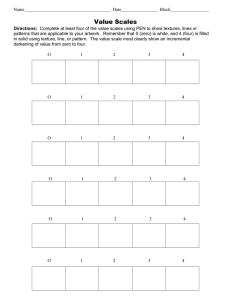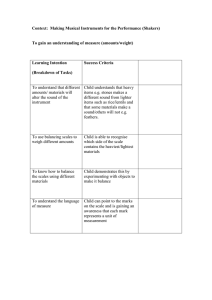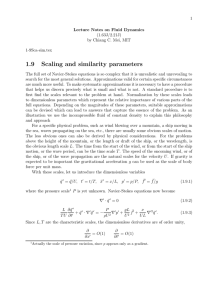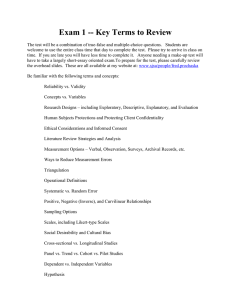GEFD SUMMER SCHOOL Some basic dimensionless parameters
advertisement
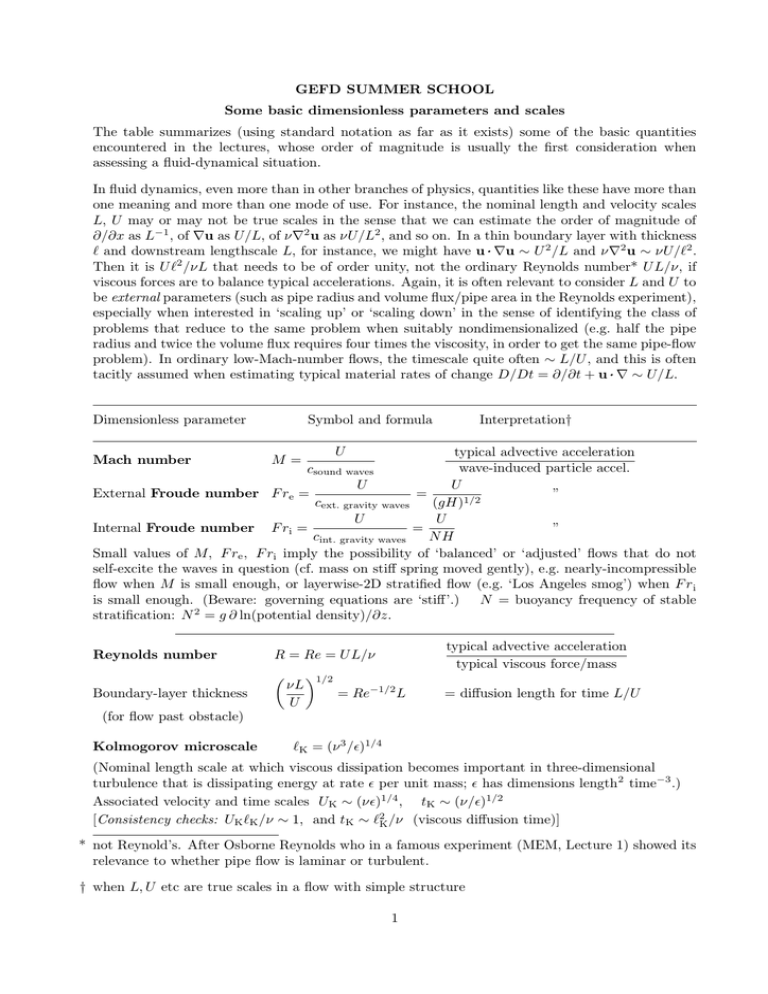
GEFD SUMMER SCHOOL Some basic dimensionless parameters and scales The table summarizes (using standard notation as far as it exists) some of the basic quantities encountered in the lectures, whose order of magnitude is usually the first consideration when assessing a fluid-dynamical situation. In fluid dynamics, even more than in other branches of physics, quantities like these have more than one meaning and more than one mode of use. For instance, the nominal length and velocity scales L, U may or may not be true scales in the sense that we can estimate the order of magnitude of ∂/∂x as L−1 , of ∇u as U/L, of ν∇2 u as νU/L2 , and so on. In a thin boundary layer with thickness ` and downstream lengthscale L, for instance, we might have u · ∇u ∼ U 2 /L and ν∇2 u ∼ νU/`2 . Then it is U `2 /νL that needs to be of order unity, not the ordinary Reynolds number* U L/ν, if viscous forces are to balance typical accelerations. Again, it is often relevant to consider L and U to be external parameters (such as pipe radius and volume flux/pipe area in the Reynolds experiment), especially when interested in ‘scaling up’ or ‘scaling down’ in the sense of identifying the class of problems that reduce to the same problem when suitably nondimensionalized (e.g. half the pipe radius and twice the volume flux requires four times the viscosity, in order to get the same pipe-flow problem). In ordinary low-Mach-number flows, the timescale quite often ∼ L/U , and this is often tacitly assumed when estimating typical material rates of change D/Dt = ∂/∂t + u · ∇ ∼ U/L. Dimensionless parameter Symbol and formula Interpretation† U typical advective acceleration wave-induced particle accel. csound waves U U External Froude number F re = ” = cext. gravity waves (gH)1/2 U U Internal Froude number F ri = = ” cint. gravity waves NH Small values of M, F re , F ri imply the possibility of ‘balanced’ or ‘adjusted’ flows that do not self-excite the waves in question (cf. mass on stiff spring moved gently), e.g. nearly-incompressible flow when M is small enough, or layerwise-2D stratified flow (e.g. ‘Los Angeles smog’) when F r i is small enough. (Beware: governing equations are ‘stiff’.) N = buoyancy frequency of stable stratification: N 2 = g ∂ ln(potential density)/∂z. Mach number M= Reynolds number R = Re = U L/ν Boundary-layer thickness µ νL U ¶1/2 typical advective acceleration typical viscous force/mass = Re−1/2 L = diffusion length for time L/U (for flow past obstacle) Kolmogorov microscale `K = (ν 3 /²)1/4 (Nominal length scale at which viscous dissipation becomes important in three-dimensional turbulence that is dissipating energy at rate ² per unit mass; ² has dimensions length 2 time−3 .) Associated velocity and time scales UK ∼ (ν²)1/4 , tK ∼ (ν/²)1/2 [Consistency checks: UK `K /ν ∼ 1, and tK ∼ `2K /ν (viscous diffusion time)] * not Reynold’s. After Osborne Reynolds who in a famous experiment (MEM, Lecture 1) showed its relevance to whether pipe flow is laminar or turbulent. † when L, U etc are true scales in a flow with simple structure 1 Dimensionless parameter Symbol and formula (gradient) Richardson number Ri = N 2 /(Uz )2 (= F ri −2 if Uz = U/H) Péclet number P e = U L/κ Interpretation† As for F ri −2 ; Uz = vertical shear. (Note that Uz H is, quite often, the relevant velocity scale.) typ. advective rate of change of temp. typ. diffusive rate of change of temp. (κ = heat diffusivity) momentum diffusivity heat diffusivity momentum diffusivity solute diffusivity Prandtl number ν/κ Schmidt number ν/κs Rossby number Ro = U/ΩL ∼ U/2ΩL (Kibel’ number in typical relative advective accel. typical Coriolis accel. ∼ U/cinertia waves (Ro ¿ 1 ⇒ rotationally stiff) Soviet literature) typical viscous force/mass typical Coriolis accel. (For relevance to spindown time Ω−1 E −1/2 , L needs to be a scale in the Ω direction) Ekman number E = ν/ΩL2 Ekman-layer thickness (ν/Ω)1/2 Diffusion length for scale time Ω−1 Prandtl’s ratio H/L ∼ f /N of scales f = 2Ω sin(latitude) (Natural vertical-to-horizontal aspect ratio for stratified, rotating flow at low F r i and Ro) Associated quantities: Rossby length Rossby height Burger number (H and L are vertical and L ∼ N H/f (also ‘Rossby radius’; no standard symbol) H ∼ f L/N (no standard symbol) 2 2 2 2 Bu = N H /f L (sometimes defined the other way up) horizontal length scales; H ¿ L in atmosphere and ocean) ∆ρ g0 H 3 (g 0 = g ) νk ρ Ra is the product ReP e for vigorous thermal convection (assuming that the velocity scale U is such that vertical advective acceleration U 2 /H ∼ buoyancy acceleration ∼ g 0 ). Rayleigh number Ra = Nusselt number total vertical heat or buoyancy flux in a thermally convecting layer conductive heat or buoyancy flux if convection suppressed Flux Richardson number Rif = vertical eddy buoyancy flux Uz × eddy momentum flux Rif arises from the turbulent energy equation for stratified shear flows. It compares the rate at which eddies do work against gravity (in reducing the stable stratification) with the rate at which they acquire energy from the mean shear Uz . † when L, U etc are true scales in a flow with simple structure 2

